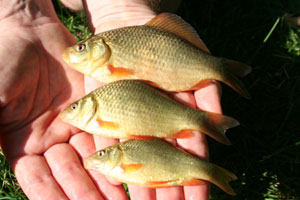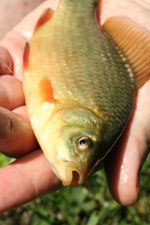Crucian Carp (carassius carassius)
Weight: Due to tendency to hybridise, the crucian record list has been ‘purged’ and only two waters in the UK are accepted as having true crucians by the British Record Fish Committee. These are Marsh Farm at Surrey and Summer Pit at Yateley in Hampshire. There are certainly plenty of other waters holding true crucians though. Both have produced 4lb plus fish but even a 1lb plus crucian is a lovely fish. Any crucian over 3lb is a truly fine specimen and the fish of a lifetime
British Record: 4lb 9oz
Length: Rarely exceeds 40cm
Lateral line: Look for between 26 and 30
Age: Can live for up to 30 years in captivity, but more likely 15 years in the wild
Preferred habitat: Associated with lily pads and farm ponds in the UK, but able to survive extreme temperatures and low oxygen levels
Feeding: Most active from May-September at dawn and dusk, foraging in the silt for natural food and sometimes coming right into the margins to do so in low light levels. Sticks very close to cover in daylight. Tends to live in small shoals. Noted for giving hard-to-hit bites and requires delicate presentation and tackle in daylight
Hybridisation: Hybridises readily, especially with common carp
Maturity: Three to four years
Spawning: Female lays up to 250,000 sticky eggs in spring in dense marginal weed
 |
Identification
Colouring
The crucian carp has a slightly more rounded shape than that of a common carp. It is fairly deep-bodied and in mature fish it has a brown colouring on its back and fantastic buttery-gold flanks. However, the appearance of the fish does vary considerably depending on the environment in which it lives
Lateral Line
Because the fish so easily interbreeds with other carp and ornamentals, this is one of the few ways that can help you identify whether the fish is a true crucian carp. On a true crucian this line will be broken up along its length and often stops before the tail
Mouth
Another feature that helps in identification. A close look should reveal the fish has a small, rubbery-looking, upturned mouth that has no barbules around it, a sure-fire clue that it’s not a common or wild carp
Eyes
The black iris of the crucian has a lighter outer ring that’s surrounded by a darker brown main colouring
Ventral Fin
These are small and in the main have a reddish-brown colour
Dorsal Fin
Unlike other species of carp, the crucian has an elongated, convex dorsal fin that has between 14 to 21 branched rays of which the weak leading ray has a lightly serrated spine
Pelvic Fin
These are fairly small compared to other species of carp and like the ventral fin have a reddish-brown colouring
Anal Fin
The anal fin is much shorter in length than those found on other carp species
Tail/Caudal Fin
The crucian has a large, concave caudal fin with rounded forks that enable the fish to power its way in the water and help it put up a spirited fight when hooked
The Life Cycle
Breeding
In spring, females produce hundreds of thousands of tiny, sticky eggs that they spill onto underwater weeds. Survival can be pretty high. We stocked our lake at college with just a hundred 15cm crucians and in three years, we have tens of thousands of beautiful, tiny crucians, though you’d never know it unless you swept a net through the marginal weed.
Early Days
The minute baby fish grab microscopic, living food like water fleas. As they grow, their attentions turn to bottom-living bugs like bloodworms, shrimps and snails. Crucians are not aggressive feeders and do not compete well with other bottom feeders. Heavy stockings of carp, for example, will usually see the beginning of the end for the crucian stock.
Growing Pains
Slow growers, even in really favourable conditions, crucians reach around 5cm after one year. A 15cm crucian could be as old as six years. This could make a really big crucian a very old fish indeed, way over ten years of age. In captivity, crucians have lived for more than 30 years!
Cross Swords
Crucians cross breed easily with goldfish (a very close relative) and common carp. If you want to be fairly certain that what you are holding is a true crucian, check the row of tiny holes (that look like minute dots) down the fish’s side – its lateral line. In a crucian this line will be broken up along its length and often stops before the tail. In a brown goldfish, or a crucian/goldfish hybrid, the lateral line most often runs all the way along the body, plus the back fin will not be high and rounded. In a crucian/common carp hybrid, look for some very small barbules around the mouth, often just one at either corner. These various hybrids are now fairly common.
China Crisis
At the moment, life for crucians in Britain is hard. Not only are they fighting off over-bearing carp and hybridisation with carp and goldfish, but they are also vulnerable to the alien Chinese tapeworm. This parasitic worm is designed to dig its head into the thick gut wall of species like the common carp. The crucian’s gut is a much finer affair and tends to get utterly destroyed by the attack.
Cold Comfort
Crucians are incredibly tough in at least two ways. Like no other British freshwater fish, they can survive truly freezing temperatures and incredibly low oxygen levels (perhaps even oxygen-less conditions). In Britain, we think of them living in warm, weedy farm ponds, but in northern Europe, they thrive in ponds under thick snow and ice for half the year! This hardiness is one of the reasons why crucians have been moved around illegally for use as pike bait, even escaping into northern waters like Scotland’s legendary Loch Lomond.
No Native?
The crucian carp is often painted as a genuine native, a true English rose amongst fishes. But it might just not be so – scientists cannot agree whether it has been here since the last Ice Age or whether it was brought here around the same time as the common carp. In Europe, crucians are farmed in many areas, although one very famous Belgian fish farming book says “they are not welcome and are always to be eliminated”. For us anglers, however, crucians are always very welcome!






